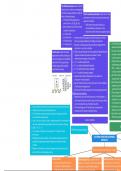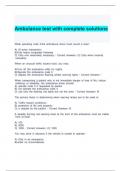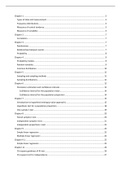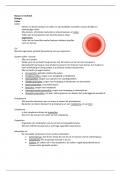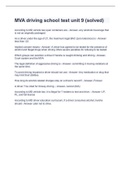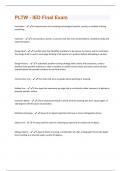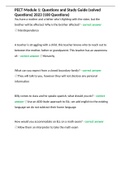The Aufbau principle states that the
electrons in an atom are arranged so
that they occupy orbitals in order of Pauli’s exclusion principle states that no two
their increasing energy. electrons in an atom can have the same four
The typical filling sequence quantum numbers.
starts from 1s, 2s, 2p, 3s, 3p This means that each orbital can
Each sublevel can hold a certain accommodate a maximum of two
number of electrons: electrons only if they have opposite spins.
s: 2 electrons
p: 6 electrons Atomic orbital: the space around the nucleus in which
d: 10 electrons there is a high probability of finding the electron.
f: 14 electrons Electron configurations describe the arrangement of In 1913, Niels Bo
electrons in an atom’s orbitals. based on Planck
Hund’s rule states that when Each principal energy level has sublevels defined by the An atom consist
degenerate orbitals (orbitals of angular momentum quantum number ℓ, which nucleus around w
the same energy) are available, determines the shape of the orbital: circular paths ca
electrons first occupy these ℓ = 0: s-orbital (spherical) These orbits are
orbitals singly with parallel ℓ = 1: p-orbital (dumbbell-shaped) called energy sh
spins before pairing ℓ = 2: d-orbital (cloverleaf-shaped) M, N, ... shells, or
ℓ = 3: f-orbital (complex shapes) nucleus outward
Superscript Number: Represents the number of As long as the e
electrons in that sublevel. energy shell, its
Eg, 2p⁴ means there are four electrons in the p sublevel Only those orbit
of the second energy level. momentum of th
Electrons fill orbitals based on increasing energy levels multiple of h/2π
Noble gas core notation: The energies of
Represents the core shell electrons of the element, in atom are quantiz
other words those electrons closer to the nucleus which numbers, as a re
are not involved in any chemical reaction. in the spectra of
Core electrons: the electrons closest to the nucleus of the atom The remaining part of the electron configuration An electron’s en
Valence electrons: outer shell electrons represents the valence shell electrons. distance from th
The effective nuclear charge: the positive charge which the Each electron in
outer electron experiences different quantu
Less than the actual nuclear charge because the electrons in Atomic orbitals
the inner shells partially neutralise the actual nuclear charge.
Zeff or Z* = Z – S Q
Effective nuclear charge
(Z= number of protons in the nucleus. S= number of core
electrons.)
Shielding: Electrons closer to the nucleus partially block the ELECTRONIC STRUCTURE AND PERIODIC
PROPERTIES
positive charge experienced by electrons farther from the
nucleus
Reduces the effective nuclear charge felt by outer electrons,
Atomic properties and periodic trends
which affects orbital energy levels
Atomic radius: Electronegativity: a measure of the Electron affinity: the energy
Principal quantum number (n) ability of an atom to attract the shared change that occurs when a
increases = orbitals become electrons to itself when bonded to neutral atom in the gas phase
larger(from top to bottom within a gains an electron to form a
electrons in an atom are arranged so
that they occupy orbitals in order of Pauli’s exclusion principle states that no two
their increasing energy. electrons in an atom can have the same four
The typical filling sequence quantum numbers.
starts from 1s, 2s, 2p, 3s, 3p This means that each orbital can
Each sublevel can hold a certain accommodate a maximum of two
number of electrons: electrons only if they have opposite spins.
s: 2 electrons
p: 6 electrons Atomic orbital: the space around the nucleus in which
d: 10 electrons there is a high probability of finding the electron.
f: 14 electrons Electron configurations describe the arrangement of In 1913, Niels Bo
electrons in an atom’s orbitals. based on Planck
Hund’s rule states that when Each principal energy level has sublevels defined by the An atom consist
degenerate orbitals (orbitals of angular momentum quantum number ℓ, which nucleus around w
the same energy) are available, determines the shape of the orbital: circular paths ca
electrons first occupy these ℓ = 0: s-orbital (spherical) These orbits are
orbitals singly with parallel ℓ = 1: p-orbital (dumbbell-shaped) called energy sh
spins before pairing ℓ = 2: d-orbital (cloverleaf-shaped) M, N, ... shells, or
ℓ = 3: f-orbital (complex shapes) nucleus outward
Superscript Number: Represents the number of As long as the e
electrons in that sublevel. energy shell, its
Eg, 2p⁴ means there are four electrons in the p sublevel Only those orbit
of the second energy level. momentum of th
Electrons fill orbitals based on increasing energy levels multiple of h/2π
Noble gas core notation: The energies of
Represents the core shell electrons of the element, in atom are quantiz
other words those electrons closer to the nucleus which numbers, as a re
are not involved in any chemical reaction. in the spectra of
Core electrons: the electrons closest to the nucleus of the atom The remaining part of the electron configuration An electron’s en
Valence electrons: outer shell electrons represents the valence shell electrons. distance from th
The effective nuclear charge: the positive charge which the Each electron in
outer electron experiences different quantu
Less than the actual nuclear charge because the electrons in Atomic orbitals
the inner shells partially neutralise the actual nuclear charge.
Zeff or Z* = Z – S Q
Effective nuclear charge
(Z= number of protons in the nucleus. S= number of core
electrons.)
Shielding: Electrons closer to the nucleus partially block the ELECTRONIC STRUCTURE AND PERIODIC
PROPERTIES
positive charge experienced by electrons farther from the
nucleus
Reduces the effective nuclear charge felt by outer electrons,
Atomic properties and periodic trends
which affects orbital energy levels
Atomic radius: Electronegativity: a measure of the Electron affinity: the energy
Principal quantum number (n) ability of an atom to attract the shared change that occurs when a
increases = orbitals become electrons to itself when bonded to neutral atom in the gas phase
larger(from top to bottom within a gains an electron to form a

